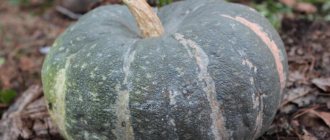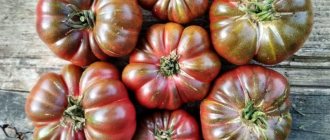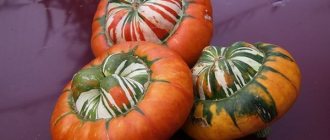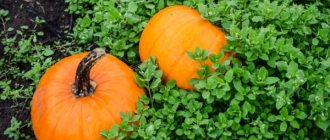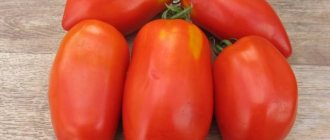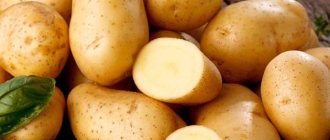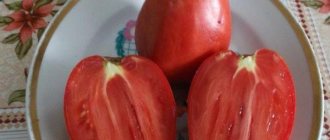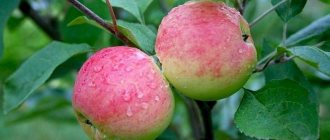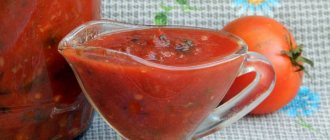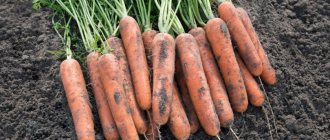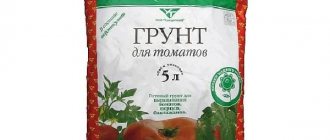What varieties are suitable for growing pumpkin in open ground?
The following varieties are best grown in open ground:
- Butternut squash. This category includes the subvarieties Vitamin, Mramorny, Tsukatny, Arbatsky, and Zhemchuzhina. The shape is round or cylindrical, the crust is soft, the color is deep orange. Butternut squash has an increased shelf life (2 years) and excellent taste.
- Pumpkin crop is hard-barked. The shape is round-cylindrical, the color is orange, the taste is pleasantly sweet. A distinctive feature is the woody-hard outer shell (difficult to cut).
- Large-fruited pumpkin. Among this category, it is worth growing the subvarieties Juno, Golosemyanka, Gribovskaya bush, Vesnushka, Almondnaya, and Dachnaya. Features: high yield, large fruit, soft coating.
In open soil, you can try to grow absolutely any variety, since pumpkin is not whimsical and capricious. The main thing is to strictly follow agrotechnical rules.
Large-fruited pumpkin and its varieties
The best varieties of pumpkin for open ground related to this type:
- Volzhskaya gray is a variety characterized by medium ripening and large fruits, the weight of which reaches 6.5 - 9 kg, the color of the pulp can be yellow or orange, its sweetness and density are moderate;
- Gribovskaya winter - a late, long-climbing variety, fruit weight is about 3 kg, the pulp is juicy, has a sweet taste;
- Crumb - ripens in the mid-late period, the plant vines are of average size, the weight of pumpkins usually does not exceed 3 kg, their color is gray with barely noticeable pink spots, the pulp is less juicy compared to other varieties, but sweet and quite dense;
- Golden Cup is a medium-ripening variety, the fruits are gray, with orange stripes, yellow inside, have a sweet taste and sufficient juiciness;
- Big Moon - forms powerful bushes, the lashes can reach 3 meters in length, the pumpkin peel can be divided into segments or have a smooth surface, the average weight of the fruit is 27 kg, especially large specimens can weigh up to 90 kg;
- Medicinal - ripens early, the yield is high, the fruits are grayish in color with a mesh pattern, and have good taste.
Conditions
The plant is considered heat-loving, but does not have any special requirements, although it loves moist soil during flowering. This is due to the fact that during this period the root system begins to develop, which needs to become stronger. If there is not enough moisture, the ovaries will fall off.
Being a “sunny” crop, pumpkin requires enough light. It does not tolerate strong winds and cold, so there should be a fence/building on the northern part of the garden.
Lighting
It is advisable to plant the crop in areas open to sunlight. This is almost the only plant that easily tolerates exposure to direct sunlight, and for 6-8 hours. Despite this, slight shading is also acceptable, which is why many gardeners compact crops with corn.
Temperature
Pumpkin loves warmth, so the optimal temperature can be considered +25 degrees. Peculiarities:
- if the temperature drops below +8-10 degrees, the seeds do not germinate;
- at a temperature of +15-20, germination occurs slowly;
- at a temperature of +25-30 degrees, the seeds hatch in a couple of days.
Soil requirements
The soil for pumpkin crops should be saturated with humus, which will allow you to get tasty and aromatic fruits of high yield. It is advisable to drain the soil and fertilize it with compost. pH acidity should be 6-6.5. The upper soil layers should not be wetted, but groundwater can pass through the lower ones.
If we talk about crop rotation, the best predecessors are beans, cabbage (necessarily early) cabbage, onions, and garlic. It is not advisable to plant pumpkin after late varieties of tomatoes, carrots and cabbage. Beets, greens, and cucumbers are considered neutral. Pumpkin can coexist with beans, radishes, beets, and corn. It is forbidden to plant next to potatoes and tomatoes.
Planting pumpkin seeds
Pumpkins are propagated only by seeds, which can be planted directly in open ground (for those living in the southern regions), or seedlings can be obtained first (for the middle zone). Seeds are harvested in the fall from the pumpkin of the current harvest or purchased in stores.
When harvesting seeds yourself, it is very important that they ripen well. You should also provide them with the correct storage conditions - optimally in damp sand in the refrigerator (but not in the freezer).
Seeds for seedlings are planted in early May, after soaking them for a day in damp gauze. This will significantly improve their germination. If you plan to plant directly in open ground, you should wait until early June.
When using the seedling method, it is very important to take into account that pumpkin does not tolerate transplantation well, and therefore it is better to plant it in peat pots. The latter must be of sufficiently large volume, at least twelve centimeters in diameter. Seedlings grown in peat pots will need fairly frequent watering and daily spraying.
When seedlings are received, the seeds are planted in moist nutrient soil (humus, garden soil, river sand), deepening them to six centimeters. Before sprouts appear, the pots are covered with film, forming a small greenhouse.
Pumpkin seeds are planted in open ground to a depth of ten centimeters. When planting, use a 1x1.5 meter pattern, since pumpkin vines and fruits require quite a lot of space, and the bush itself needs plenty of nutrition. After planting the seeds in the garden bed, they also need to be covered with polyethylene until the shoots germinate and strengthen.
Soil preparation
Preparatory work begins in the fall, so think about the place for the pumpkin in advance. What needs to be done: clear the area of weeds and crops that grew this year and prepare organic fertilizer. To do this, mix 60 grams of superphosphate, 30 grams of potassium chloride, 10 kg of humus (14 kg of manure can be used instead). This amount should be enough for 2 square meters. m. Fertilizer is applied in the cold for plowing.
To ensure looseness, coarse sand or peat can be added along with organic matter. In very slightly acidic soils, it is advisable to add wood ash. In spring, digging is not required, but it is necessary to remove weeds and level the top layer of soil with a rake.
The best varieties of pumpkin for open ground for Siberia and the Urals
The Urals and Siberia are Russian territories where frosts last until mid-June. Taking this into account, it is necessary to choose planting material that can withstand cold and frost.
Read about growing tomato seedlings at home here.
Smile
The variety allows you to get the harvest ahead of schedule. Pumpkin harvesting can occur as early as 3 months from the moment of germination. This plant grows as a bush, has a compact size and allows you to get a high yield.
With proper care, one bush can produce 3 kg of pumpkin. The fruits have a thick orange peel. The taste of the pulp is sweet and juicy. The Ulybka variety has a long shelf life at room temperature.
Read about growing tomatoes in a polycarbonate greenhouse here.
Freckle
The variety withstands sudden changes in temperature, therefore it is considered the most suitable for cultivation in Siberia. The fruits have a hard bark, and the pulp resembles melon in its taste. This variety is considered sweet, the flesh is crispy, and the weight of one fruit is no more than 3 kg.
Russian
This crop is also excellent for planting in Siberia and the Urals. With proper care you can get high yields.
You can find a list of the best varieties of tomatoes for a polycarbonate greenhouse at this link.
The plant has strong immunity to all pests and diseases. For Russians, cold and frost are not scary. Ripe fruits are dark orange in color and taste like melon.
Seedling method
In the southern regions of the country, you can plant seeds directly in open ground. But for northern latitudes, preference is given to the seedling method of growing pumpkin plants.
Checking and preparing seeds:
- Since pumpkin seeds are large, checking them is not difficult. It is necessary to select complete elements for planting. If there is no time to do this manually, the seed material is soaked in water. Floating grains are considered unsuitable because they are empty.
- For quick germination, seeds are immersed in water at a temperature of no lower than 40 degrees, no higher than 50 degrees. Keep for about 4 hours.
- After this time, the seeds are placed on moistened gauze (can be replaced with a piece of cotton fabric).
- The elements rolled up in fabric are placed in a container and left to germinate in the room. To prevent the fabric from drying out, moisten it 1-2 times a day with warm water (room temperature).
- After sprouts form, the wrapped seeds are transferred to the refrigerator (temperature +3 degrees). Keep for 3 to 5 days.
Rules and terms of landing:
- It is recommended to plant seedlings in open ground at the age of 22 days. Therefore, depending on climatic conditions, if the seedlings are planted in open ground, for example, on May 25, the seeds are sown on May 3, if transplantation is planned for June 6, then the seeds are planted on May 15.
- If night frosts are expected during these periods, experienced gardeners and summer residents recommend setting up local greenhouses. For this, ordinary plastic bottles corresponding to the size of the seedling bush are used. After planting, the bush is covered with a bottle with a cut bottom, which is slightly deepened into the ground.
- It is advisable to plant seeds in peat cups. This is necessary due to poor tolerance of transplantation measures. The minimum size of the cup should be 10x10 cm.
- The soil for seedlings is peat mixed with sand.
- Rules for planting hatched seeds: pour earthen substrate into a glass so that 3 cm remains from the top edge, pour water on top, place the seed, add soil, moisten again.
- For the first 3-4 days after planting the seeds, the air temperature should not be below 25 degrees. Further, the temperature can be reduced to +18. After a week of growth, the temperature drops another 3 degrees. This is necessary for further adaptation of the plant to the open air.
- It is advisable to plant 2 seeds in one glass. When both grains germinate, one sprout is removed by pinching at the very root.
Feeding and watering:
- The plant needs to be watered regularly - the soil should not be dry or too wet.
- When it comes to feeding, preference is given to a solution of water and mullein in a ratio of 1:10. Fertilizer should be applied 12-14 days after planting the seed.
Ringing of seedlings is carried out 10 days after planting the seeds. During this period, the soil will shrink a little, so it is necessary to fill the pots with additional substrate. An additional layer is created around the stem in a circle.
Planting in open ground:
- Seedlings should be replanted after 21-22 days. By this period, three full-fledged leaves should have formed, having a rich green tone.
- Planting is carried out in rows in which holes are made 30-35 cm deep.
- The distance between rows is 40 cm.
- After creating the holes, fertilizer made from potassium sulfate and superphosphate is placed on their bottom. Additionally, soil mixed with peat and wood ash is filled in. Ordinary soil is sprinkled on top, after which watering is carried out (about 2 liters of water), and seedlings are planted.
- Before planting, the bottom and walls of the peat glass are slightly cut.
Agricultural technology for growing zucchini
Planting zucchini
To plant zucchini, choose a sunny place protected from cold winds, preferably on the southwestern and southern slopes. The higher the illumination, the sooner fruiting occurs and the higher the yield.
The predecessors for the crop can be any vegetables except pumpkin. After them, plants are not recommended to be planted for 3 years, which will avoid the accumulation of diseases in the soil.
Zucchini develops well in fertile, humus-rich soil with a neutral reaction. In the fall, the area for it is filled with organic matter and, if necessary, limed. If fertilizers were not applied during the autumn digging, in the spring 10-15 kg of compost, 50-60 g of superphosphate, and a little wood ash are added per 1 m2.
Seeds begin to germinate at +12-15°C, seedlings do not tolerate frost, which determines the timing of planting zucchini. They are planted in open ground no earlier than the end of May; to extend the period of consumption of fresh fruits, sowing is carried out several times with an interval of 5-6 days.
To speed up the germination of seeds, they are pre-soaked in a solution of mineral fertilizers or a growth stimulant for 24 hours, or germinated until they hatch, or kept for 5 hours in warm (50°C) water.
Plants are placed according to a 70x50 cm pattern, no more than 3 pcs. per 1 m2. When planting, place a handful of humus and ash and 3-4 seeds in each hole. Subsequently, only one, the most developed specimen is left in the hole. Seeds are buried 5-7 cm, on heavy soils - 3-5 cm.
For early consumption, they use growing zucchini in a greenhouse and under film cover, as well as planting seedlings.
Planting and growing zucchini seedlings
Growing zucchini seedlings allows you not only to get the first fruits earlier, but also to increase the overall yield.
For planting, use purchased soil with a high humus content and a neutral reaction, or prepare a soil mixture, the approximate composition of which is 50% peat, 20% turf soil, 20% humus, 10% sawdust. For high acidity, add chalk or ash.
Pre-prepared seeds are sown in separate containers or peat pots, 1 piece each. 20-30 days before the expected landing. For cultivation in greenhouses and under film covers, zucchini seedlings are planted in early April, for open ground - in early May.
Before emergence, the temperature should not be lower than 20-22 °C, then, to prevent the seedlings from stretching, it is reduced to 13-15 °C at night and 15-18 °C during the day for 5-6 days, after which it is raised again to 20-20 °C. 22 °C.
Feed with mineral fertilizers (5-7 g of superphosphate and 2-3 g of urea per 1 liter of water) or mullein solution, the first time 10 days after germination, the second time a week later. If the soil is sufficiently filled with nutrients, one feeding is enough, a week before planting. At the age of 30 days, seedlings are transferred to greenhouses and under shelters in early May, and into open ground in early June. Replant with a clod of earth so as not to damage the root system, and deepen to the cotyledons.
Care and agricultural technology of zucchini in open ground, in greenhouses and on the balcony
After germination or planting of zucchini seedlings in the ground, growing and caring for them involves timely watering, weeding, loosening and fertilizing.
In the phase of 4-5 leaves, the stem is slightly hilled, which promotes the development of additional lateral roots. Before the leaves close, the plant needs several weedings and loosening.
Feed twice, during flowering and at the beginning of fruiting, using a solution of organic or mineral: phosphorus, potassium, and in the first feeding, nitrogen fertilizers. Zucchini does not tolerate fertilizers containing chlorine.
In central Russia, the cultivation of zucchini in open ground on an industrial scale is carried out without irrigation, but a prolonged lack of water affects the harvest. In garden plots and summer cottages, plants are watered once a week with warm water, which is especially necessary immediately after planting seedlings, during flowering and mass harvesting. Watering and fertilizing help increase the size of fruits and prevent their premature ripening. Watering is stopped 7-10 days before final harvesting.
When growing zucchini in greenhouses, caring for them is in many ways similar to open ground farming techniques. A special feature is the need for frequent ventilation to maintain humidity at 60-70% and temperature +24-26°C during the day and +14-15°C at night, otherwise the plants may shed their ovaries en masse. If the bushes grow strongly, part of the leaves in the middle or lower part is removed to improve ventilation.
To attract pollinating insects, zucchini can be sprayed with a solution of sugar and boric acid. This technique is especially relevant for increasing yield in greenhouses and greenhouses.
When using compact, early-ripening varieties that are resistant to unfavorable conditions, it is possible to grow zucchini on a balcony or loggia. The early varieties Beloplodnye, Anchor, Roller, hybrid Belogor, and almost all zoned zucchini varieties are suitable for these purposes: Aeronaut, Zebra, Tsukkesha. All of them are compact, relatively cold-resistant, and tolerate soil and air drought.
Plants are planted in pots with a diameter of at least 10 cm or in boxes at a distance of 50-70 cm, with seeds or seedlings according to the rules described above.
Further agricultural technology is similar to growing in a greenhouse or open ground.
In the absence of pollinating insects, zucchini is pollinated by hand, transferring pollen from male flowers to the stigmas of female flowers. After the first frost, the plants are removed, the containers are washed and disinfected.
Harvesting for all types of cultivation is carried out 2 times a week, the fruits are picked when they reach a size of 15-20 cm. A delay in harvesting causes the zucchini to become overripe, which reduces the number of new ovaries and sharply reduces the overall yield.
Seedless method
The seedless method can be used mainly in the southern latitudes of the country.
Rules for planting seeds in open ground:
- Checking and preparing seeds is carried out in a similar way as with the seedling method. Namely, the seeds are sorted, soaked, and germinated. But you can also plant unsprouted grains.
- Sowing is carried out approximately May 10-20, depending on climatic conditions.
- The soil temperature should correspond to +12 degrees.
- The distance between the rows should be one and a half to two meters, between plants - 80-100 cm. Before sowing, holes are dug and filled with fertilizers, as with the seedling method. After planting, watering is carried out.
Growing conditions
Pumpkin is a heat-loving crop, but it cannot be called a southern vegetable: it ripens well in the middle zone. Some summer residents near Moscow plant the latest ripening varieties in the spring in the corners of cucumber greenhouses, and when warm weather sets in, they release the vines outside: occupying greenhouses with such huge bushes is unprofitable. Basically, pumpkins are grown in open ground. In the Moscow region, both seedling and non-seedling methods of cultivating this crop are used equally.
Since most varieties of pumpkins form long vines (up to three meters or more), a serious problem in small areas is choosing a place to place it. Pumpkins, like cucumbers, love to climb vertical supports, including even fruit trees. Using this property, land-poor summer residents often plant a pumpkin near the fence, and then help it send its lashes up. If this is not possible, trellises or even canopies are often specially built so that pumpkins grow on the “second floor” and do not interfere with the planting of other vegetables.
In fact, the problem of lack of space is largely far-fetched: after all, an average family only needs to plant 3-4 bushes, and the feeding area for each of them is about 1 m2. Pumpkins are often planted in unnecessary metal barrels, large bags, and even directly on compost heaps. But in any case, the plants should be well illuminated by sunlight.
To save space, summer residents come up with a wide variety of techniques
The second problem, besides choosing a location, is that pumpkins require a large amount of nutrients, preferably organic. It is impossible to grow a real crop without humus or good compost. And the soils themselves cannot be anything. Pumpkin grows best on dark, light loams and sandy loams with neutral acidity. Before it, zucchini and cucumbers cannot be planted in the chosen place.
The pumpkin patch does not have to be completely dug up. Often pumpkin is planted almost like a bush: large planting holes (almost holes) are dug into which large doses of fertilizer are added. One bush requires about a bucket of rotted manure and a good handful of wood ash. Mineral fertilizers do not need to be used before planting; it is better to apply them later, in the form of fertilizing.
In the conditions of the Moscow region, it is advisable to prepare planting holes in the fall, and in May, water them well with warm water, possibly with the addition of ammonium nitrate (5–10 g per bucket of water), then cover with film and keep it like that until planting the pumpkin: no matter , seedlings or seeds.
The most common methods of growing pumpkins:
- Classic way. The stems of the plant are located on the ground. Their direction is spontaneous, creeping.
- Trellis method. Used for small varieties of pumpkin crops. Along each row, wooden supports are installed, which are horizontally equipped with wooden slats. Wire is not suitable in this case, as it will not support the weight of the fruit. The height of the structure should reach 2 m. The distance between plants is a maximum of 40 cm. During cultivation, it is necessary to pinching and shaping, tying fruits and shoots to supports and trellises. Many gardeners put a net on the fruit, which is convenient to attach to the structure.
- On compost heaps. In the area allocated for planting pumpkins, compost heaps are arranged, in which small holes are made for filling the soil. Next, the seeds are sown. A prerequisite is to immediately cover with film, which is removed after the formation of the first shoots. Advantages - there is no need for fertilizing during cultivation; absolutely any variety can be sown.
- Method according to Galina Kizima. This method is unique in that pumpkins can be grown without seedlings even in the northern regions. It is based on digging trenches, at the bottom of which plant residues are placed. It is they who create the temperature regime necessary for the plant. You need to dig trenches in the fall (the depth corresponds to 2 bayonets of a shovel), the vegetation is laid down immediately, and in early spring it is covered with soil. After germination of seedlings, film cover is required until the required air temperature stabilizes. Pros - no need to fertilize.
When to plant pumpkin seeds for seedlings in 2020
By the time of planting in the garden, the pumpkin seedlings should be approximately 20-25 days old. Overgrown seedlings adapt much worse in the soil after transplantation. In addition to weather conditions, experts recommend taking into account the recommendations of the Lunar calendar.
According to the Lunar calendar
The influence of the Moon on the growth and development of plants has long been proven. There are favorable and unfavorable days for planting. For root crops and plants that produce aboveground crops, different time periods will be suitable.
Favorable days for planting pumpkin seedlings in 2021:
- in March - 7, 14, 20;
- in April - 6, 18, 24;
- in May - 6, 20, 22;
- in June - 4, 18, 20.
The following dates are not suitable for sowing:
- in March - 6, 21;
- in April - 5, 19;
- in May - 5, 19;
- in June - 3, 17.
If it was not possible to land on favorable days, you can do it in a neutral time period. In this case, you will definitely not cause any harm to future seedlings.
Caring for pumpkins in open ground
Many gardeners believe that pumpkin plants do not require special care. Therefore, the only thing they do after planting is to occasionally water it with water. However, to achieve maximum yield and high quality fruits (size, aroma, taste), it is important to follow certain agrotechnical rules and pay attention to this crop.
Watering
Irrigation should be done on a regular basis, as pumpkins love moisture. Despite the fact that the root system is quite powerful and extends laterally and deeply over a considerable distance, the surface roots still need to be watered.
In addition, the roots pump out moisture from the soil layers, which evaporates through the foliage, so there is practically no liquid left in the root system and stems.
Irrigation rules:
- Before and after emergence, up to the formation of the bush, it is necessary to water in small portions, but daily. The golden rule is that the volume of water increases gradually.
- The largest amount of liquid is added during mass flowering and fruit formation.
- The amount and frequency of water applied is determined by the specific pumpkin variety.
- You should not water the plant a few days before the fruit is fully ripened.
- The temperature of the liquid should not be lower than +19-21 degrees. Cold water is completely excluded, as the culture will die.
- After irrigation, it is advisable to loosen at the very base of the main stem.
Mulching
This process is used by gardeners who do not have the opportunity to water their garden frequently (they rarely come to their dacha, there is no required amount of water, etc.). Mulching makes it possible to maintain the desired level of moisture in the soil for a long time.
How it is done: a special mulch is placed around the stem, thanks to which weeds do not additionally grow. The following materials are used as mulch (necessarily of natural origin, so that the soil “breathes” air):
- sawdust;
- needles from pine, spruce, fir, thuja and other coniferous trees;
- peat;
- tops from other crops that have already been collected;
- weeds;
- small tree branches (mixed with grass);
- foliage.
Loosening
Since the root system is quite developed, an increased amount of oxygen is needed. For this purpose, the loosening method is used, which is performed after watering or a day after irrigation. When loosening, weeds are simultaneously pulled through.
Pollination
If pumpkin plants are not pollinated, the risk of ovary rot increases. Pollination is usually carried out by insects, but there are not enough of them everywhere, so artificial pollination is used. What do we have to do:
- pick a male flower;
- pluck the petals with gentle movements (so as not to knock off the pollen);
- touch the pistils (anthers) to the female inflorescence.
The time for the procedure is before lunch. If it is not possible to carry out manual pollination using the method described above, use simple advice: prepare honey water and spray the plants (female flowers).
Bush formation
The bush is formed without fail, as this makes it possible to get a better harvest. For this, 3 main methods are used:
- Method No. 1. It is necessary to leave only the main stem on which fruits grow in quantities of 2 to 3 pieces.
- Method No. 2. The main and one side stem remain. The quantity on each shoot is 2 pumpkins.
- Method No. 3. There are two shoots, one main stem. On each of them there remains mainly one fruit.
It is important to pinch the point of further growth of the stems. To do this, after the fruit ovaries, you need to count 5 leaves. This is the point.
Top dressing
Pumpkin crops require organic and mineral fertilizers, which increases productivity and prevents the development of diseases. The need for feeding is due to the fact that the plant has too large fruits, and therefore requires a large amount of useful nutrients.
Fertilizer application times:
- The first time fertilizing is carried out after the formation of five leaves;
- the second time - when lashes form;
- the third and subsequent times - every 14-15 days.
What can you feed:
- solution of slurry and water (ratio 1:10), initial consumption for 6 plants - 10 liters of liquid, further consumption for the same number of plants - 2 buckets;
- nitrophoska (the first time 10 grams of the product is used per plant, then another 5 grams are added to this dose);
- wood ash must be added (1 cup per bush);
- mullein solution, minerals (phosphorus, potassium, etc.), industrial fertilizers of simple, complex and mixed types.
Sprinkling of lashes
If you do not apply powder, the leaves, ovaries and lashes will break off under the negative influence of precipitation, wind, and mechanical action. It is especially worth noting another advantage of the method - when the vines are covered with soil, an additional root system develops, which draws moisture and nutrients from the soil, which contributes to the plant’s nutrition.
How to sprinkle:
- powdering time – the lashes reach one meter;
- unravel the elements;
- spread on the ground in a given direction;
- Sprinkle each lash with soil in 2-3 places.
When does pumpkin ripen in the Moscow region?
With proper care of pumpkins in the open ground, in the middle zone, early and mid-ripening varieties ripen well, producing not too large fruits.
For gardeners who make every effort to grow large-fruited varieties and nutmeg pumpkins, famous for their delicious taste and aroma, it is important not to miss the moment of harvest and know exactly how to determine that the pumpkin is ripe.
There are several signs that the fetus is ready:
- By the time they ripen, the stem of the pumpkin becomes coarser and becomes like a dry plug.
- The vines and leaves begin to turn yellow and wither.
- The bark changes color and a pattern characteristic of the variety appears on it. Although there are plants that produce gray, green, and cream pumpkins, most varieties produce orange or all shades of yellow fruit.
- Not only the color of the peel changes, but also its hardness. While the bark of an ovary can be easily damaged by a fingernail or a rough whip, the bark of a pumpkin ripened in the Moscow region becomes extremely durable.
And although the most delicious fruits are those that have ripened in the sun, it is important to harvest the crop before the onset of persistent cold weather.
Do not forget that autumn in the Moscow region is insidious in that during the daytime the sun shines and the temperature is quite comfortable for pumpkins, but at night on the soil the September air cools to very low levels.
Therefore, no matter how the summer resident cares for the pumpkin in the open ground, it is better to remove the unripe fruits from the garden at the first doubt. Frosts can cause serious damage to even mature fruits, reducing their quality and shelf life.
Pumpkins intended for storage are cut off, leaving a stalk at least 4–6 cm long, sorted and left to dry. After 8–10 days of staying in a dry, warm room or outdoors, under a canopy, if the weather permits, the fruits ripen, the bark hardens, and the cut on the cutting dries out. If the nights are cold, as happens when pumpkins ripen in the Moscow region in September or early October, the fruits are covered with hay or non-woven material. Unripe pumpkins are ripened indoors, which may take from 10 days to 1.5 months.
Planting pumpkin seedlings in open ground - video
How to deal with diseases and pests?
Pumpkin is not very susceptible to diseases and insect attacks, however, if preventive measures are not followed, there is a risk.
Powdery mildew
This is the most common disease of pumpkins. It appears as an abundant whitish coating on the leaf part of the plant. As it progresses, it spreads to stems, lashes, and fruits. As a preventive measure, excessive thickening should not be allowed; you should water mostly with warm water and pull out the grass in a timely manner.
You can get rid of powdery mildew using chemicals - Strobi, Topaz. The drug is applied no later than 20 days before harvesting, to the aboveground part and soil. The affected areas must be removed.
Fruit rot
Pumpkin varieties are subject to different types of rot:
- White is characterized by rotting of half-ripe and ripe fruit. Signs: initially a white coating forms, which acquires a putrefactive structure. The skin of the pumpkin is affected, after which the rot spreads inwards. To combat, the plant is treated with a solution of copper sulfate. The rotten part must be removed. To prevent the disease, it is necessary to clear the area of weeds, even those that have already been picked (deposits).
- Root rot is localized on the root system and stem. The symptom is a brownish coating. You can cure the plant by adding dry soil to the root part. Prevention: avoid high humidity (do not overwater the plant).
- Black is distinguished by the formation of gray-whitish spots on which there is a black coating. The location of the lesion is fruits, stems, leaves. Since the cause of the disease is the transmission of infection by insects, wind and tools, it is necessary to promptly remove the affected areas of plants and disinfect the soil.
- Gray rot occurs against the background of a fungal infection. It appears on the ovaries as a watery-gray mold-like coating. The spots are covered with conidiophores and small black sclerotia. Treatment: applying copper sulfate paste to sore spots. As a preventative measure, it is forbidden to over-moisten the soil and thicken the plants.
Mosaic
The disease is of viral etiology, leading to serious pathological changes. Leaves, ovaries and fruits are affected.
The sign is the covering of the affected areas with a mosaic-type dotted pattern, the color of which varies from light to dark green. The leaves dry out and curl, and the surface of the fruit becomes prominent.
Pumpkins affected by the mosaic virus should not be consumed. To prevent infection, it is necessary to get rid of weeds, remove affected plants, and then burn them in a fire.
Other diseases
Other pests, insects and diseases:
- Bacteriosis. It manifests itself in the formation of brown spots on the leaf part of the plant. It spreads quickly among crops, but affects pumpkins in rare cases. Treatment involves removing the affected elements.
- Spider mites are localized on stems and underneath leaves. It can be recognized by the presence of cobwebs. At home, spraying with tinctures of garlic or onion is carried out.
- The melon aphid sometimes attacks pumpkin crops. Insects spread from weeds, so they need to be pulled out in a timely manner. The site of aphids is the lower part of the leaves, which curl after infection.
- Cutworm caterpillars. Pests feed on stems, leaves and fruits, so the plant quickly dies. To prevent their appearance, it is necessary to dig up the garden, destroy weeds and sprinkle with lashes.
- mildew is downy mildew. Signs: yellow dried spots, purple-gray coating. Control methods: Kartotsid, Kuproksat, Copper oxychloride. Prevention: disinfection of seeds and soil.
- Slug. The presence of a pest can be recognized by damage to the leaves, on which holes and silvery stripes form. How to get rid of it: spray the plant with Creotsid, set traps (watermelon rinds, moistened rags, cabbage leaves).
- Anthracnose. The stem and leaf part are affected - there is a pink coating, holes, and indentations. For the fight, Bordeaux mixture is used.
- Germ fly larvae. It is the larvae that destroy pumpkin sprouts and seeds. To prevent this, seed material must be treated with Fentiuram or other insecticidal agents.
- Click beetle or wireworm. A completely harmless insect for pumpkins, but only in adulthood. The danger comes from larvae that destroy seedlings and roots. The larva is collected manually, the soil is treated with Bezudin.
Almost all insects can be fought with a soap solution (1 piece of brown laundry soap per bucket of water). In many cases, Karbofos diluted with water helps (50-60 grams per 10 liters).
Growing pumpkins (step-by-step agricultural techniques)
How to grow pumpkin: through seedlings (in the middle zone and to the north), by direct planting of seeds in the ground (in the south). Pre-preparation of pumpkin seeds: not necessary, but to shorten the period of emergence of seedlings, it is recommended to soak or germinate them.Growing pumpkins in open groundGrowing pumpkin seedlingsDates for planting pumpkin seeds for seedlings: late April - first half of May Additional lighting: when growing seedlings in an apartment on south-facing windows - not required. Recommended temperature: 25-27*C. Pumpkin seeds begin to germinate at temperatures above 10*C, but for normal growth and development they need 25-30*C during the day and 18-20*C at night. Picking pumpkin seeds is not required. Important. Pumpkin seedlings are immediately grown in pots (recommended diameter - 14-15 cm) so that there is no damage to the root system during planting. At the same time, when planting a pumpkin seed, the pot is only half filled with soil. 10-12 days after sowing, when the growth of the subcotyledonous stem slows down (in the first days it stretches very much, especially with a lack of light), moist soil is poured into the pots, while twisting the stem with a corkscrew, so that only the cotyledonous leaves appear from the ground. This technique is called ringing pumpkin seedlings. During the period of growing seedlings, it is recommended to carry out two fertilizing with complex mineral fertilizers. Also, it is necessary to ensure that the pumpkin plants do not touch the leaves and, as the seedlings grow, move the pots apart. Pumpkin seedlings ready for planting should have 3-5 true leaves. Planting pumpkins in the groundDates for planting pumpkin seedlings in the ground: end of May - first ten days of June (25-35-day potted seedlings are used). Also in central Russia, it is possible to plant pumpkin seeds directly into the ground (approximately in mid-May), but under cover. In this case, it is recommended to plant 2-3 pieces at once. seeds, and after they sprout and the real leaves appear - leave one, the strongest plant. Planting pattern: Because pumpkin is a strongly climbing plant, the distance between plants in a row should be 1 -1.5 m, and between rows - at least 2 m. It is recommended to plant pumpkin seedlings on ridges or mounds, in holes 8-10 cm deep. In each hole Plant one plant at a time. The best predecessors: potatoes, cabbage, tomato, legumes. Important. It is better to choose a place for planting pumpkins that is dry and warm, well-warmed during the day and retains heat at night. It can be planted on a pile of garbage (after having first poured a sufficient layer of nutritious soil on top) and on a compost heap (by making a larger hole at the planting site and adding garden soil to it along with ash and superphosphate). It is recommended to harden off pumpkin seedlings a week before planting. To do this, the daytime temperature is reduced to 15-17*C, and the night temperature to 12-15*C and ventilation is increased. Before planting pumpkin seedlings in a permanent place, it is recommended to add 1.5-2 kg of compost (or humus) to each hole and pour plenty of warm water at the rate of 1-2 liters per hole. Pumpkin seedlings are planted in the resulting pulp, covering the sides with dry soil so that a crust does not form. If the pumpkin seedlings were grown in a plastic pot, remove the plant carefully, trying not to damage the lump. If in a peat pot, plant it in the hole along with the pot. Attention! For better survival, it is recommended to cover pumpkin seedlings in the first week after planting (with cut-off 5-liter plastic bottles or paper caps). Pumpkin growing and careWatering. It is recommended to water the pumpkin with warm water, not at the root, but in the annular groove around the stem. Because Since the pumpkin has a powerful and highly branched root system, going to a depth of up to 3 meters, it should be watered moderately - the pumpkin itself is able to extract the missing moisture from the deep layers of the soil. And when the pumpkin ovaries reach the size of a fist, it is better to switch to drip irrigation. In garden and dacha conditions, it can be imitated with a bucket of water installed next to the plant. The end of a thick cotton rope is lowered into the bucket, and its second end is wrapped around the whip and sprinkled with earth near the roots. Fertilizers and fertilizing. Since pumpkin produces a large amount of green mass (leaves, stems and fruit), fertilizing must be done every 7-10 days. The first feeding is organic - 2 liters of slurry per bucket of water with the addition of 40 g of superphosphate and 30-50 g of wood ash. The second feeding is mineral - 20-30 g of ammonium nitrate, 40-50 g of superphosphate and 20-30 g of potassium salt per 10 liters of water. In the future, organic and mineral fertilizing are alternated. Feeding consumption: from 1 l/plant at the initial stage of growth, to 5-7 l/plant at the end of summer. Bush formation. Since the pumpkin forms a mass of long shoots, it must be shaped to obtain large fruits. The main stem is pinched when 2-3 fruits have formed on it, leaving 5-6 leaves above the fruit, and 2 side shoots - after the first fruit appears on each, also leaving 5-6 leaves above the fruit. All fruitless shoots and shoots that appear later are removed. Important. Before closing the plants in rows, after rain or watering, it is recommended to loosen the soil. To prevent the wind from turning over the lashes, they are pinned or sprinkled with moist soil. Diseases and pests of pumpkin.Powdery mildew Small white powdery spots appear on the upper and then lower sides of the leaves and on the stem. Subsequently, the affected leaves turn yellow and die, and if the disease develops severely, the fruits are also affected. Olive spot The disease manifests itself in the form of ulcers on the stems, and brown spots form on the leaves. Oily spots appear on the fruits, which eventually turn into light brown sores with sporulation of an olive-colored fungus. A gelatinous fluid is secreted at the border between healthy and diseased tissue. The affected ovaries die, and the fruits lose their marketable quality. Pests The greatest damage to pumpkins is caused by slugs, which spoil the ripening fruits. Attention! To combat all pumpkin diseases, it is recommended to use modern effective drugs approved for use in personal gardens, strictly observing the recommended dosage, timing and frequency of treatments. To combat slugs, sprinkle the ground around the plant with ash, tooth powder or superphosphate. You can also use simple traps, such as wet rags, and collect slugs from them daily. Receiving commercial products.Early ripening pumpkin varieties ripen 85-90 days after germination, late ripening varieties ripen 120-150 days. Pumpkin fruits are usually harvested all at once, after the first slight frost. The fruits are cut with a sharp knife, leaving a stump of the stalk (which should be in the drying stage) measuring 3-4 cm. This protects the fruit from rotting, which during storage begins exactly from the place where the stalk is torn off. When harvesting pumpkins, you should also avoid mechanical damage to the fruit, which can cause them to be stored worse and rot faster. Attention! To make the pumpkin tastier, as the fruit grows, some of the leaves near it are removed so that it is well illuminated by the sun. In open ground, contact with the ground may cause pumpkin fruits to deteriorate, so it is recommended to place non-rotting material (plywood, boards) under them. If you decide to grow a giant pumpkin, then only one (less often two) fruits are left on one plant, and all other ovaries are promptly removed. |
Galimax for you from here
Series of messages “PUMPKIN, ZUCCHINS”:
Part 1 - All about pumpkin. Part 2 - Growing zucchini (Ganichkina) ... Part 4 - Pumpkin, Zucchini Part 5 - Planting zucchini - good tips Part 6 - Growing pumpkin (step-by-step agricultural technology) Part 7 - Growing zucchini (step-by-step agricultural technology)
Harvesting
The timing of the pumpkin harvest depends on climatic conditions, summer weather, variety, planting time, so there are no specific criteria. The average ripeness period is 3-3.5 months.
How to determine the ripeness of a pumpkin?
To understand exactly when to pick a pumpkin, you need to know the ripeness indicators:
- The leaf part begins to dry out and turn pale (the bright color disappears).
- The fruits become saturated with orange color.
- The pumpkin rind becomes harder.
- The stalk becomes stiff and dry.
Pumpkin picking
In order for pumpkin to be stored for a long time, it is necessary to harvest it correctly. What rules to follow:
- the weather should be sunny and dry;
- the fruit is torn off along with the stalk;
- the length of the dry stalk should not be less than 4 cm;
- after harvesting, the pumpkins are placed in a room at room temperature (it is important to ensure that the room is dry);
- drying lasts 3 days, after which the fruits are transferred to a permanent storage location.
Storage rules
The shelf life of pumpkin depends on the variety. For example, early pumpkins cannot be stored for more than a month, mid-season pumpkins retain their quality for one and a half to three months, late types can be stored for up to 4 months, but there are varieties that can be kept for up to 2 years.
Storage Features:
- Pumpkin crops should be stored for a long time in a cool, dark and dry room;
- air temperature – 2-7 degrees;
- place - cellar, basement, warehouse, storage room;
- Before laying, each fruit is carefully inspected for damage - holes, scratches and other defects in the rind should not be allowed.
You can watch the following video about growing and pinching pumpkins:
Pumpkin is a “patient” and unpretentious plant, but without proper care it is impossible to obtain a decent level of yield and quality of fruit. Therefore, if you decide to start growing pumpkin crops, be sure to study all the requirements and criteria. If necessary, consult with more experienced gardeners or agronomists.
0
0
Copy link
Planting pumpkins in 2021: sowing dates, cultivation and care
Pumpkin is one of the most unpretentious crops. By correctly following all the recommendations, it becomes easy to grow it, and pumpkin has a lot of beneficial properties. For example, you can make jam, porridge pie from it... We should also not forget that each region of our country has its own climatic characteristics. Taking this into account, you can get a rich pumpkin harvest.
High in sugar
If you want to enjoy a tasty and sweet pumpkin, then you need to know which varieties will allow you to get such a harvest. Sweet pumpkin is actively used as food, baked or in the preparation of sweet porridges for children.
This information will help you understand how to plant a pumpkin on a compost heap.
Early ripening variety Kroshka
The variety is early ripening. Harvesting can occur 90-100 days from the formation of the first shoots. The fruits are small in size, weighing 2-3 kg per one.
Their shape is round, slightly flattened, and has a light gray color. The pulp has a sweet taste, sleepy, dense consistency, and bright yellow color. Even with long-term storage, the product retains excellent taste.
Atlas with healthy fruits
A characteristic feature of this variety is the formation of large fruits. The weight of one product is 20-50 kg. Despite its large size, the pumpkin has juicy, dense and sweet yellow-orange flesh.
The surface of the fruit is slightly segmented and smooth. Late ripening variety. Harvesting occurs on days 110-130.
Big Max
Late ripening variety with high yield. It is necessary to grow seedlings in April. Harvesting can occur on the 130th day. The weight of one pumpkin is 40 kg. The pulp is orange in color, juicy and sweet.
You may also be interested in information about fertilizing in open ground.
Yield and tasty variety – Almond pumpkin
This variety is characterized by orange-yellow flesh. The taste is at the highest level. With proper care, the plant allows you to get a high yield. The weight of one pumpkin reaches 4-7 kg. Harvesting can occur on day 115-120. Retains its appearance and taste for a long time.
Description and planting of the Volga gray variety
The variety is characterized by early ripening. With proper care you can get a high yield. The pumpkin has a light gray color and a slight greenish tint. The shape of the fruit is slightly flattened. The pulp is egg-yellow in color, tastes sweet, juicy and has a dense consistency.
The plant has strong immunity to diseases such as white rot. For a long time it retains its taste and presentation.
Pumpkin: choice of variety, features of cultivation and storage
One of the largest varieties is Atlantic Giant. The average weight of an adult pumpkin of the presented variety is 80 kg
Pumpkin varieties
sweet pumpkin with a sugar content of 13% can gain only 4-5%
Despite the huge number of different varieties and the fact that almost all of them are very tasty, juicy and nutritious, it is worth highlighting the sweetest and early ripening varieties.
Pumpkins at this time
In the middle it is advisable to let it lie down
Features of care
Hybrid 72 was obtained at the Poltava Regional Agricultural Experimental Station. The plant is long-climbing and powerful. The fruit is irregularly spherical, weakly segmented or smooth, weighing 6.2
8.7 kg, light or greenish gray. The pulp is yellow, 4 thick
5 cm, loose, slightly sweet. The fruits contain 5.5
7% dry matter, 3.6
4.9% sugars. From full germination to fruit harvesting 114-126 days. Transportability and keeping quality of the fruit are good. Productivity 3.6
In general, growing pumpkins is not difficult. This applies to all varieties.
Don’t forget about domestic varieties - Michurinskaya, Kroshka, Lechebnaya, Ulybka.
, since it is designed for more southern latitudes, where there is more sun. That is why when choosing you need to consider:
Decorative pumpkin
(more than 5-6 months) can lead to loss of taste, but this has practically no effect on the appearance of the fruit.
thick (large-fruited varieties) and thin (portioned varieties) cylindrical
You can eat and choose seeds from them, by the way, they are the most delicious. Fruits if desired
For the strip, the harvest is usually harvested in September, and in the south - at
How to grow pumpkin ( )
Features of growing different varieties
This variety in central Russia, as a rule, does not ripen in the garden, but it grows well.
Gymnosperm
Hard-barked pumpkin. The name of the variety is no coincidence. A characteristic feature: a leaf with white spots and the fruit, when ripe, is also covered with dark green round spots - real freckles on a pumpkin. Cold-resistant, very early ripening variety, ripens in 80 days. Sowing seeds in the second ten days of May according to the 70x70 cm pattern. The plant is compact, non-branching. Four or more fruits weighing 1.8-3 kg are simultaneously formed on it. The surface of the fruit is smooth, yellow-green, and when fully ripe it is light yellow with a fine mesh pattern.
Large-fruited pumpkins are best preserved; vegetables with hard bark are worse. Butternut squash has low shelf life.
Muscat
Care is very simple. It includes watering, fertilizing and weeding the top layer of soil. Watering is done once a week. Hilling several times a season. The bush should be fertilized 14 days after planting and during flowering. The following are used as top dressing: ash, nitrophoska, mullein infusion.
Butternut
When caring for a pumpkin, it is important to observe 2 conditions:
Butternut pumpkin is a well-known variety in Russia; it is easy to identify by its pear-shaped shape and smooth surface. It is believed that this kind of pumpkin is most suitable for making porridge, although the sugar content, as a rule, does not exceed 5.5-6%. The pumpkin is small; with good watering and fertilization, its weight will be about 30 kg, and the average one will be 9-15 kg. Time until full ripening is 100 days.
Immediately after cleaning
- peduncle. The seeds are tasty, although some varieties have a very thick, hard seed coat. The pulp of the fruit is sweet and, depending on the variety and hybrid, has a varied consistency (crispy, soft, hard, starchy, loose, fibrous, etc.)
- can be left in storage for a month to ripen, but do not overexpose them, otherwise the seeds will germinate.
- Complete death of leaves.
- Medium-late cold-resistant variety. Ripens in 115 days. It was developed to replace the old variety Gribovskaya Zimnyaya, only earlier ripening and, in a favorable year, more productive. The plant is climbing, 4 m or more long, branched, forms 2-3 lateral shoots. The fruit is smooth, flattened, dark green, covered with a barely noticeable coarse mesh. The pulp is bright orange, 3-4.5 cm thick, dense, juicy, tender, and very sweet when fully ripe.
Climatic conditions
The climate of the Moscow region is moderate continental. Seasonality is pronounced, summers are warm (the hottest month is July), winters are cold and snowy, with stable snow cover and frequent thaws. The winter period lasts from the end of November to the end of March, the average air temperature is -13 °C. In March-April, night frosts often occur. Winds are strong and frequent (up to 4.7 m/s).
In the warm season in the Moscow region there is more precipitation than in winter (up to 300 mm). The air warms up to 18-20 °C. Daylight hours are 15-16 hours. There are 65 clear and sunny days a year in the region. Droughts occur rarely (once every 5-6 years).
The sweetest varieties of pumpkin and how to choose them correctly - advice from an experienced gardener
Early ripe sweet pumpkin varieties
mostly cylindrical in shape, oval, less often round, and
of which it is recommended for winter storage. They are removed before the onset of frost (in
(Mozoleevskaya 49, Golosemyannaya, Biryuchekutskaya 27, Almondnaya 35,
If you do this in the rain, don't forget
The sweetest pumpkin varieties are mid-season varieties with the highest yields
The variety was bred at the All-Union Research Institute for Selection and Seed Production of Vegetable Crops. The plant is long-climbing. The fruits are flattened, gray in color, contain 18
20% dry matter, including 8
10% sugars. The pulp is thick, bright orange in color, juicy. Fruit weight 3.2
4.2 kg. The variety is easy to grow and can be stored until the next harvest. At the same time, the taste of the fruit improves. The variety is late-ripening (128–140 days pass from full germination to ripening). Purpose for table use, suitable for processing. large-fruited variety. In central Russia and more northern regions, it is advisable to grow it through seedlings.
In the Moscow region and Leningrad region, summer is short and cool. That is why it is better to grow the selected pumpkin varieties here using the seedling method. The rest of the care is no different.
Decorative pumpkin varieties are edible, but only while the vegetables are young. But even in this case, they are inferior to classic varieties in terms of taste characteristics.
The sweetest pumpkin - choose late-ripening varieties
But medium-sized pumpkins are the most popular. They are easy to grow, harvest and store. The classic variety with orange flesh and skin is Hokkaido. Weight is 2-3 kilograms.
"Not all gold that... contains a lot of sugar." It's worth noting that the sweetest pumpkin varieties tend to need very good conditions to grow: plenty of moisture, lots of sun, lots of liquid fertilizer, and the like. Often even the most
Today, there are more than 800 varieties and hybrids, and only 35 of them are truly sugar and even fewer are well suited for home cultivation. Which varieties of pumpkin are the most delicious and sweet, and which option is right for you - read and choose further!
Sweet varieties of pumpkin - is it necessary to choose the sweetest?
The stalk is thin, elongated, pentagonal. The bark of the fruit is most often green with intermittent stripes or light beige in autumn. Pumpkins grown in the Moscow region need to ripen for at least 2 months. Moscow region - in mid-September). poorly stored. They are one of the first to be removed from the field. Food maturity occurs in late August - early September.
- Dry the vegetables.
- Variety selected by the Bashkir Research Institute of Agriculture. The plant is of medium thickness, the fruit is medium-sized, weakly segmented, almost smooth, weighing 4.2
7 kg. The color of the fruit is pink or dark orange with gray stripes and spotting. The pulp is light orange or orange-yellow, 4 thick
5 cm. The variety is early ripening, 84-93 days pass from full germination to fruit harvesting. The fruits contain 6.8
9.4% dry matter, 4.8
4.1 mg% carotene. Their transportability is good, shelf life is 3 months after removal. Purpose: fodder and table. Yield 4
6 kg/m2.
- Each of them has numerous subspecies. The species differ from each other in the shape of the edge of the lower leaf, male and female flowers, the color of the fruits, seeds, and have very clear and constant differences in the nature of the stalk.
In cold regions such as the Urals and Siberia, cultivation is possible only by seedlings. Seedlings must be received in early May. In June, the pumpkin is already planted on the compost heap. Do not forget about abundant watering, fertilizing and pinching.
Pumpkin prefer light. Young plants are thermophilic
Moon influence
The moon has a great influence on the growth and development of plants. When its phases change, the activity of sap movement in plant cells changes. This must be taken into account when planning sowing work and sowing seeds for seedlings or in open ground, when picking seedlings and planting them in open ground or in a greenhouse, when applying fertilizing, and pest control. Work with fruit trees in the garden should also be planned and carried out taking into account the lunar phases.
There are 4 lunar phases:
- growing (the outline of the moon in the sky resembles the letter P, if you mentally draw a line to it on the left);
- full moon (moon in the shape of a circle);
- waning (the horns of the month are turned to the right; the satellite in the sky resembles the letter C);
- new moon (moon not visible).
During the waxing phase of the moon, sap moves upward from the earth's surface, and the above-ground parts of plants (stems and leaves) actively develop. During this period, it is recommended to plant and sow those crops that form a harvest above the ground. During the waning phase of the moon, the movement of liquid is directed downward, towards the roots of plants. The root system is actively forming and developing. The process of absorption of nutrients from the soil is activated. At this time it is useful to sow root vegetables and potatoes.
On the days of the new moon and full moon, plants go into a state of sleep, the movement of sap slows down, and all processes are suspended. Any actions related to planting, sowing plants, picking seedlings and feeding seedlings cannot be carried out. This can have a detrimental effect on the growing season. It is allowed to get rid of weeds and destroy parasites.
Important!
The days of the full moon and new moon are the day before the onset of the phase and the day after.
